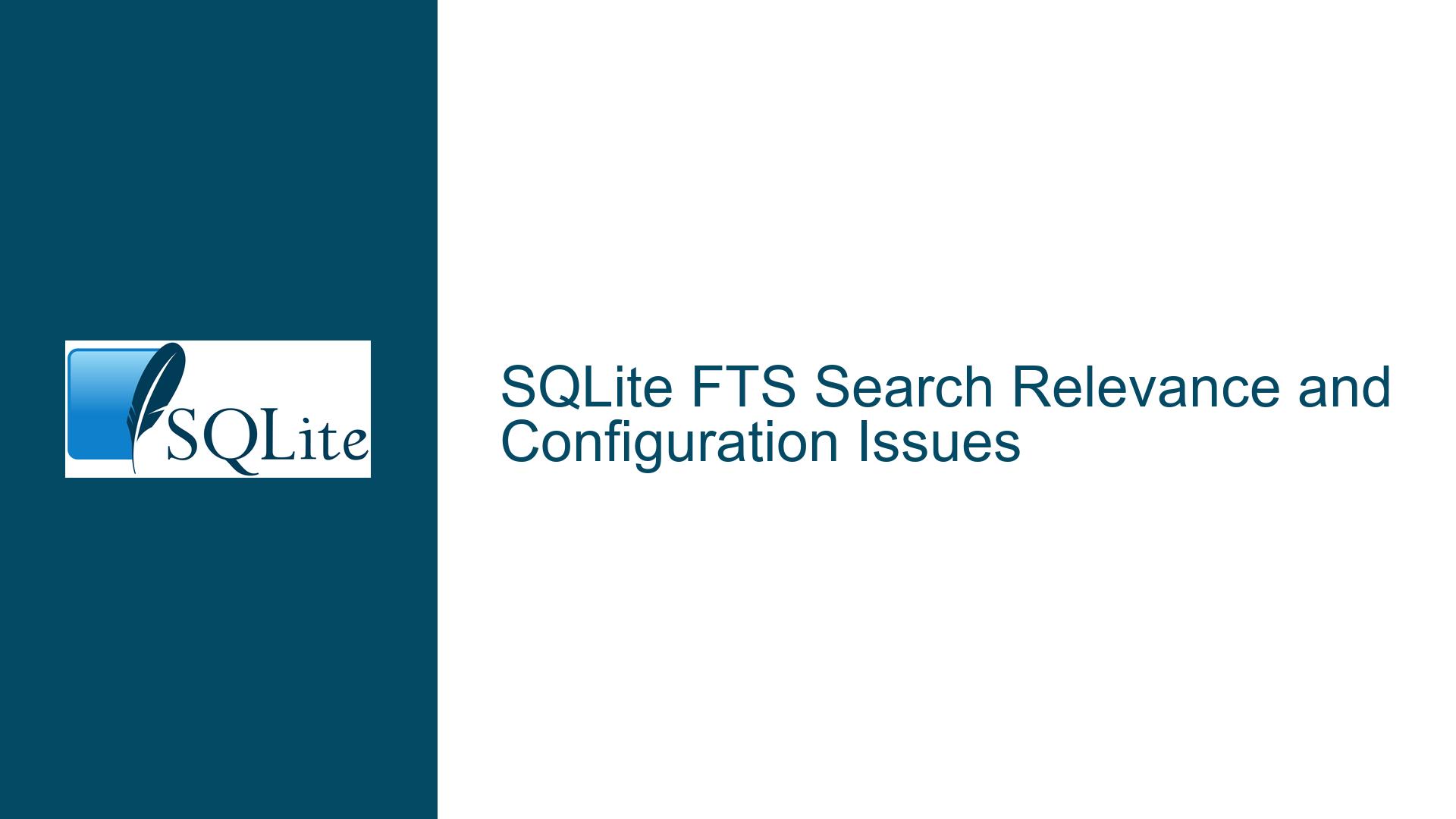SQLite FTS Search Relevance and Configuration Issues
SQLite-utils CLI Tool FTS Search Relevance and Configuration Challenges
The SQLite-utils CLI tool, particularly its sqlite-utils search command, introduces a powerful feature for performing Full-Text Search (FTS) queries against SQLite databases. This functionality is designed to work seamlessly with both FTS4 and FTS5 tables, offering users the ability to search and retrieve data based on relevance. However, the implementation of FTS search relevance, especially when dealing with FTS4 tables, presents several challenges. These challenges stem from the inherent differences between FTS4 and FTS5, particularly in how relevance scoring is handled. FTS5 includes built-in relevance sorting, whereas FTS4 requires a custom scoring function, which can lead to inconsistencies and performance issues if not properly configured.
The primary issue revolves around the configuration and optimization of FTS tables to ensure that search results are both accurate and relevant. The sqlite-utils search command must handle these configurations correctly to provide meaningful search results. Additionally, the tool must manage the differences in relevance scoring between FTS4 and FTS5, which can be particularly tricky when dealing with large datasets or complex queries. The relevance scoring function used for FTS4, while effective, may not always align with user expectations or the built-in capabilities of FTS5, leading to potential discrepancies in search results.
Interrupted Write Operations Leading to Index Corruption
One of the critical issues that can arise when using the sqlite-utils search command is the potential for index corruption, particularly during interrupted write operations. This can occur when the database is being updated or modified while a search operation is in progress. SQLite’s transactional model is designed to handle such scenarios gracefully, but there are edge cases where interruptions can lead to index corruption, especially in FTS tables. FTS tables rely heavily on their indexes to provide fast and accurate search results, and any corruption in these indexes can severely impact the performance and reliability of search operations.
Interrupted write operations can occur due to various reasons, such as power failures, system crashes, or even manual interruptions during database updates. When such interruptions happen, the FTS index may not be fully updated, leading to inconsistencies between the index and the actual data. This can result in incomplete or incorrect search results, as the index may point to non-existent or outdated data. In the context of the sqlite-utils search command, this can manifest as missing or irrelevant search results, which can be particularly problematic when dealing with large datasets or complex queries.
Another potential cause of index corruption is the improper configuration of the FTS table itself. The sqlite-utils enable-fts command is used to configure FTS on a table, but if this command is not executed correctly or if the table schema is not properly designed, it can lead to issues with the FTS index. For example, if the columns selected for FTS are not appropriately indexed or if the FTS table is not properly maintained, it can result in index corruption over time. This is especially true for FTS4 tables, which require more manual intervention compared to FTS5.
Implementing PRAGMA journal_mode and Database Backup Strategies
To mitigate the risks associated with interrupted write operations and index corruption, it is essential to implement robust database management strategies. One of the most effective ways to protect against data corruption is to use SQLite’s PRAGMA journal_mode feature. The PRAGMA journal_mode command allows you to configure how SQLite handles transaction logging, which can significantly impact the database’s resilience to interruptions. By setting the journal mode to WAL (Write-Ahead Logging), you can ensure that changes to the database are logged before they are applied, reducing the risk of corruption in the event of an interruption.
In addition to configuring the journal mode, it is crucial to implement regular database backup strategies. Regular backups can help you recover from data corruption or loss, ensuring that your FTS indexes remain consistent and reliable. SQLite provides several tools and techniques for backing up databases, including the .backup command and the VACUUM command. The .backup command creates a copy of the entire database, while the VACUUM command rebuilds the database file, removing any unused space and ensuring that the data is stored efficiently.
When using the sqlite-utils search command, it is also important to monitor the health of your FTS indexes regularly. This can be done by running periodic checks on the indexes and rebuilding them if necessary. The sqlite-utils rebuild-fts command can be used to rebuild the FTS index for a table, ensuring that it remains consistent with the underlying data. This is particularly important for FTS4 tables, which may require more frequent maintenance compared to FTS5.
Another strategy to consider is the use of transactions to ensure atomicity and consistency when performing write operations. By wrapping write operations in a transaction, you can ensure that either all changes are applied, or none are, reducing the risk of partial updates that can lead to index corruption. This is especially important when dealing with large datasets or complex queries, where the risk of interruptions is higher.
In conclusion, while the sqlite-utils search command provides a powerful tool for performing FTS searches in SQLite, it is essential to be aware of the potential issues that can arise, particularly with FTS4 tables. By understanding the challenges associated with relevance scoring, index corruption, and interrupted write operations, and by implementing robust database management strategies, you can ensure that your FTS searches remain accurate and reliable. Whether you are working with FTS4 or FTS5, taking the time to properly configure and maintain your FTS tables will pay off in the form of faster, more accurate search results and a more resilient database overall.






